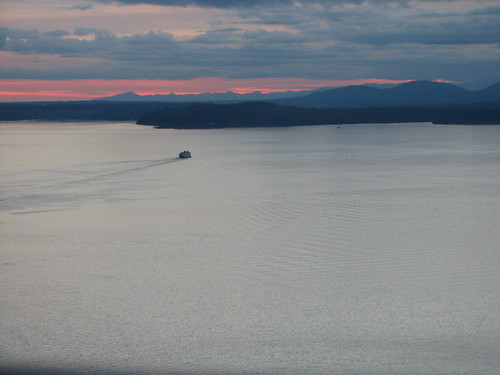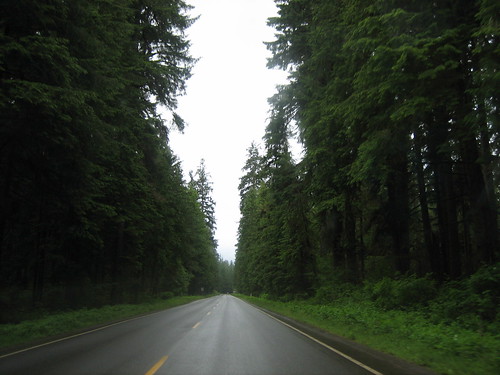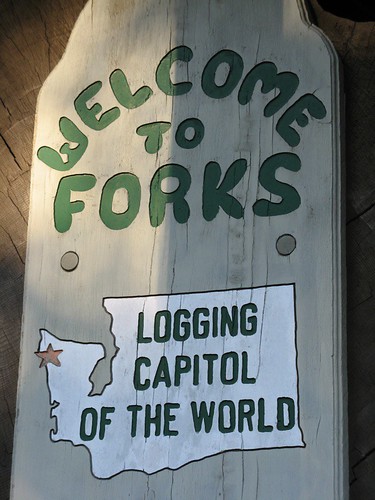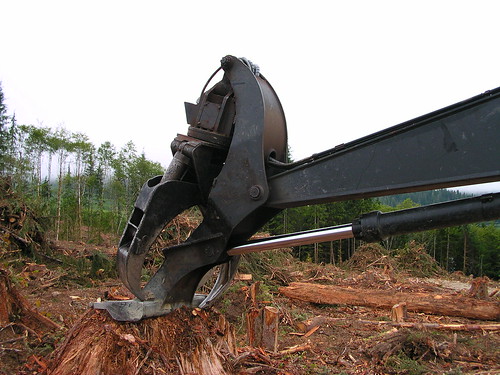
As admirable a city as Seattle is, I am most charmed by the region's topography and ecology. From the sea stacks and eroding bluffs of the Pacific coast to the alpine forests and lakes of the Olympic and Cascade ranges, this corner of the country is an aesthetic and geologic marvel.

Jocelyn explained that the tectonics of the area are among the most complex and dynamic on Earth, a result of three-way action by the North American, Pacific and Juan de Fuca plates. The Olympic range, for example, tops out at approximately 8,000 feet, a relatively low elevation when compared to the mighty Cascades, just 90 miles to the east. This is because the Olympics are what geologists term an accretionary wedge, a section of the ocean floor pushed to the surface as one plate - in this case, the Juan de Fuca - is subducted under another - here, the North American continent. By contrast, the Cascades, like most mountain ranges, are the product of volcanism, and the elevation of Mount Ranier is almost twice that of any Olympic cousin.
Were I more geologically inclined, I'd dig deeper, but I nearly failed the "Rocks for Jocks" course I took in undergrad, and my enthusiasm for the field is superficial, though genuine.

On my third day in Washington, Michael and I ferried across Puget Sound, picked up Highway 101 and drove around the top of the Olympic Peninsula to the western, rainy side of the mountains, where I was reacquainted with the peninsula's stunning beaches and the marvelous Hoh Rainforest. On the way, we drove through the town of Sequim (pronouced "squim"), where my paternal grandmother is buried, and passed not far south of Neah Bay, where, twenty years ago, my father and I boarded a head boat to catch my first Pacific halibut (Hippoglossus stenolepis).
About halfway between Sequim and the Highway 112 junction for Neah Bay, 101 jags south to trace the shore of Lake Crescent. Like many glacial lakes, Crescent glows turquoise, as though dyed. Fine sediment, or rock flour, generated by glacial erosion and carried to the lake by meltwater streams, is responsible for the striking coloration. Now suspended in the water, these particles absorb all light wavelengths except blue. Unlike most of its glacial relatives, however, Crescent's water is exceptionally clear. (This trait is attributable to its low nitrogen levels, which prevent or discourage algae growth.)

A shadow-green wall of Douglas firs (Pseudotsuga menziesii), western hemlocks (Tsuga heterophylla), western red cedars (Thuja plicata), and whitebark pines (Pinus albicaulis) rises abrupt from Lake Crescent's waterline and from 101's shoulder. The Olympic Peninsula is home to one of the largest areas of intact old-growth forest in the United States. Much of the territory is heavily logged, however, and 101's scenic drive offers as many scarred landscapes as it does breath-taking vistas.
My choice of words, though, reveals a liberal, urban bias. The work of loggers, after all, is itself "breath-taking." Certainly, it was more heroic when a team of men and oxen felled and transported a Titan of the forest using only axes, two-man saws, falling wedges and greased skids, but giant tree harvest remains impressive in our mechanized age, and the inhabitants of Forks, Washington, are proud of their historic livelihood. Indeed, the town's nickname is "Logging Capital of the World."

Although timber extraction on the peninsula didn't begin in earnest until the mid- to late 1800s, it was then the principal economic impetus and it remained so throughout the 20th century. Today, however, Forks residents are forced into defensive postures as their way of life is condemned by progressive politics and federal regulation (even if population growth and rampant consumerism ensure that the timber industry will remain active for some time to come). As with most issues of environmental sustainability, an objective, thoughtful consideration of timber harvesting should generate nuanced discussion - for example, short-rotation forestry and windrowing are undeniably destructive practices, but not all harvesting measures are ecologically unsound - but the passionate parties on either side of the picket line prefer to simplify and shout.

In the early 1990s, this shouting reached a fever pitch when the Northern spotted owl (Strix occidentalis caurina), a species in decline and dependent on old-growth forest for its habitat, became nationally famous (or infamous, depending on your perspective). The polarizing emblem of a conservation crusade, the owl was, for a time, a victim of its unsolicited celebrity. Although automation of the timber industry, and not any bird species, led to a sharp decline in jobs, Forks loggers (and those sympathetic to their cause) nailed owls to the doors of local environmentalists and displayed bumper stickers reading "Kill a Spotted Owl - Save a Logger" or "Are You an Environmentalist or Do You Work for a Living?" Predictably, the logging camp pointed accusatory fingers at Seattle's condo-enviro types, and the rural-urban cultural rift widened. Almost twenty years later, this animus remains and Forks, a blue state town on the bluer coast, is decidedly red.
This narrative is familiar to the coal miners of rural West Virginia and Kentucky. Like the northwestern loggers, they fight to protect their jobs amidst increased scrutiny and the condemnation of their employers' methods. In 2005, Erik Reece, a contributing editor to Harper's Magazine, wrote "Death of a Mountain," an essay about the desperate, ugly war of words and litigation in that region. Reece recounted the bitter minutes of a public hearing held at the Hal Rogers Center, in Hazard, Kentucky. "The wife of a miner pleaded for her husband's job, then asked, 'What use are the mountains to us other than coal?'" A elderly miner "hinted at the conspiracy afoot by the rest of the state to keep eastern Kentucky poor. He wanted the federal government and the Army Corps of Engineers and the Environmental Protection Agency to leave this region and its people alone to mine as they saw fit."
Although I cringe when I read such sentiments, it's understandable that miners and loggers feel this way. The suburban or urban environmentalist does little to endear himself to those rural residents, farmers included, who work with natural resources. In his book, "Heron Hill Chronicle," my father writes of the intellectual divide between rural conservationists and urban preservationists.
"Sadly, in drawing up their list of enemies, preservationists have alienated most of their strongest potential allies: people who also care about endangered species and rain forests but who understand that perpetuating nature is - first and foremost - hard physical labor far removed from the feel-good realm of petition signing....Real conservation is about planting filter strips along erodible stream margins and riprapping the banks to prevent swollen currents from undercutting them. It's not about save-the-whale rallies. Real conservation is about constructing and annually maintaining waterfowl nesting boxes. It's not about sending money to organizations that make the impossible promise to restore all the waterfowl populations of North America. Real conservation is hands-on, net-gain, local habitat manipulation and species management. It's not about letting nature take its course."
As unattractive as his position is to both the urban environmentalist and the rural logger (who rarely, if ever, thinks about installing nesting boxes or riprapping stream banks), it is a realist's perspective. Man is part of nature; we can not extract ourselves, no matter how stubbornly we insist on our exceptionality. The life of our species, like that of the individual, is finite, and just as each of us chooses to avoid reckless behavior (most of the time), so too should humanity. Reasonable decision making, however, requires that we avoid binary arguments and, in the case of old-growth forest conservation, that foresters, logging companies and environmentalists gather at the same table to achieve some practical compromise.

Unfortunately, in our capitalist system, state and federal incentives are needed to bring those parties together. A "green future" is tenable only if the necessary changes in technology and lifestyle generate an altogether different kind of green: cash money. Until alternative energy cheerleaders and their allies assuage the concerns of those citizens dependent on income provided by logging and mining companies, the hard-working, blue-collar folks will remain united in opposition to the relatively privileged mouthpieces of environmentalism.
Photo credits: Puget Sound, Picturehell; Hurricane Ridge view, Ryan Hadley; Highway 101, MorleyRoarly; Lake Crescent, Harry Hunt; Forks sign, Idrose; 101 clearcut, Hungry Hyaena; Logging with windrows, Brewbrooks
(More pictures of my trip can be found here. And, again, a big thank you to the photographers who I've ripped from for this post. More posts about the trip will follow.)

6 comments:
Great essay, Chris.
Did not know your father writes...
Thank you, Sunil.
And, yes, my father makes his living as a freelance writer. He's written over 30 books on conservation, angling, hunting and ecology, one of which was nominated for the Pulitzer Prize some years ago. All the hours I sat on the floor, drawing pictures, while he nearby scribbled across yellow legal pads perhaps left their mark.
I hope that you're doing well.
Hi Chris!
Ever seen Robert Adams "Turning Back" ?
Inspired by the bicentennial of the Lewis and Clark expedition, photographer Robert Adams’s most recent work presents a new look at the territory these explorers covered and the results of their effort. Titled Turning Back: A Photographic Journal of Re-exploration, the project considers the explorers’ historic journey as they returned to the East. Starting at the Pacific, Adams traveled along the Columbia River, recording the geography and how the land has been used. His photographs show the coastal tourist areas, the vast acreage of timber cultivation and clearcutting farther inland, and the small family farms of eastern Oregon. The pictures offer a reflection on the promise described by Lewis and Clark — a meditation on what was lost and what is retained, what we value regionally and as a people with a common history.
Molly:
Yes. Some of his pictures are exceptional, and all are striking.
I wrote a bit about that particular series in this post. I felt that the space - in NYC, Matthew Marks Galelry - didn't serve the works well. I'd rather look at them in book form, actually.
Chris,
Thanks for using my Crescent Lake picture. My son spotted it and pointed me to your blog.
My wife and I visited the Pacific Northwest last August and September, driving the PCH from Seattle to Crescent City, CA. We then finished the trip by continuing up to Crater Lake.
What a trip! Reading this brought back a lot of memories and makes me wish I could get back out in that area again soon. It's absolutely beautiful...except for those clearcuts. Loved the lighthouses, sea stacks, redwoods, mountains, ocean, lakes, whales, birds, elk, etc.
In a few years we plan to finish the journey, picking up at Crescent City and driving the length of California to Mexico.
See you on the road!
Harry Hunt
Johnstown, PA
Harry:
And thank you, in turn, for not minding my using the picture.
Have a great visit back to the other coast!
All the best,
C
Post a Comment